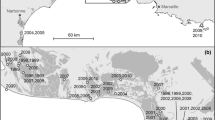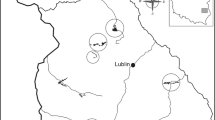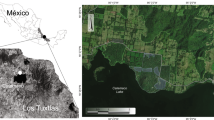Abstract
Natal emigration by male and female mantled howlers (Alouatta palliata), and subsequent immigration into breeding groups, is well documented for the free-ranging population on Hacienda La Pacifica, Costa Rica, but secondary transfer was considered rare (Glander in Int J Primatol 3:415–436, 1992). Population surveys in 1998 and 2006 caused us to question our assumptions and to re-evaluate our long-term data set from a post hoc perspective. We first identified all animals observed or captured as adults in more than one non-natal group anywhere in the population. We then systematically analyzed joining or leaving by adults in seven groups tracked for various times from 1975 to 2005 for patterns suggesting secondary transfer. Fourteen adults (nine females, five males) were found in two different non-natal groups as adults. In addition, one male and one female that became dominant and reproduced in their natal group later transferred to a second group, and one female was known to be a tertiary transfer. Data from the seven tracked social groups indicate that 35% of all the males and 29% of all the females were potential secondary transfers. In these groups, males leaving or joining was not associated with group size or absolute number of females. Females leaving or joining was not associated with group size or absolute number of males, but females left groups with more females and joined groups with fewer females. Both sexes left groups with unfavorable sex ratios for their sex and joined groups with sex ratios more favorable for their sex. Since a favorable sex ratio is associated with reproductive success in other howler populations, this suggests secondary transfer as a reproductive strategy. Other factors could also influence secondary transfer.
Similar content being viewed by others
References
Agoramoorthy G, Rudran R (1993) Male dispersal among free-ranging red howler monkeys (Alouatta seniculus) in Venezuela. Folia Primat 61:92–96
Alberts S, Altmann J (1995) Balancing costs and opportunities—dispersal in male baboons. Am Nat 145:279–306
Altmann J (1989) Primate males go where the females are. Anim Behav 39:193–195
Anderson-Bell Corp. (1993) Abstat 7.01. Anderson-Bell Corp., Arvada
Arroyo-Rodriguez V, Asensio N, Cristobal-Askarate J (2008) Demography, life history and migrations in a Mexican mantled howler group in a rainforest fragment. Am J Primatol 70:114–118
Behie AM, Pavelka MS (2005) The short-term effects of a hurricane on the diet and activity of black howlers (Alouatta pigra) in Monkey River, Belize. Folia Primatol 76:1–9
Boinski S, Sughure K, Selvaggi L, Quatrone R, Henry M, Cropp S (2002) An expanded test of the ecological model of primate social evolution: competitive regimes and female bonding in three species of squirrel monkeys (Saimiri oerstedii, S. boliviensis, and S. sciureus). Behaviour 139:227–261
Bradley BJ, Doran-Sheehy DM, Vigilant L (2007) Potential for female kin associations in wild western gorillas despite female dispersal. Proc R Soc B 274:2179–2185
Calegaro-Marques C, Bicca-Marques JC (1996) Emigration in a black howling monkey group. Int J Primatol 17:229–238
Chapman CA, Pavelka MSM (2005) Group size in folivorious primates: ecological constraints and the possible influence of social factors. Primates 46:1–9
Chapman CA, Rothman JM (2009) Within-species differences in primate social structure: evolution of plasticity and phylogenetic constraints. Primates 50:12–22
Clarke MR (1983) Infant-killing and infant disappearance following male takeover in a group of howling monkeys (Alouatta palliata) in Costa Rica. Am J Primatol 5:241–247
Clarke MR, Glander KE (2005) Male tenure and reproductive success in a one-male vs a multi-male group in free-ranging howling monkeys in Costa Rica. Neotrop Prim 13:23–27
Clarke MR, Glander KE (2008) Natal emigration by both sexes in the La Pacifica population of mantled howlers: when do some stay? Am J Primatol 69:195–200
Clarke MR, Zucker EL (1994) Survey of the howling monkey population of La Pacifica: a seven-year follow-up. Int J Primatol 15:29–41
Clarke MR, Zucker EL, Scott NJ Jr (1986) Population trends of the mantled howler groups at La Pacifica, Guanacaste, Costa Rica. Am J Primatol 11:79–88
Clarke MR, Zucker EL, Glander KE (1994) Group takeover by a natal male howling monkey (Alouatta palliata) and associated disappearance and injuries of immatures. Primates 35(S4):435–442
Clarke MR, Glander KE, Zucker EL (1998) Infant–nonmother interactions in mantled howling monkeys. Int J Primatol 19:451–472
Clarke MR, Crockett CM, Zucker EL, Zaldivar M (2002) Mantled howler population of Hacienda la Pacifica, Costa Rica from 1991 and 1998: effects of deforestation. Am J Primatol 56:155–163
Clarke MR, Ford RT, Arden D, Glander KE (2007) Survey of the Howler population of La Pacifica, 2006. Am J Primatol 68(Suppl):55–56
Clarke PMR, Henzie SP, Barrett L, Rendall D (2008) On the road again: competitive effects and condition-dependent dispersal in male baboons. Anim Behav 76:55–63
Cooper MA, Aureli F, Singh M (2004) Between-group encounters among bonnet macaques (Macaca radiata). Behav Ecol Sociobiol 56:217–227
Crockett CM, Janson CH (2000) Infanticide in red howlers: female group size, male composition, and possible link to folivory. In: van Schaik CP, Janson CH (eds) Infanticide by males and its implications. Cambridge University Press, Cambridge, pp 75–98
Crockett CM, Pope T (1993) Consequences of sex difference in dispersal for juvenile red howler monkeys. In: Pereira M, Fairbanks L (eds) Juvenile primates: life history development and behavior. Oxford University Press, New York, pp 104–118
Cunningham E, Janson C (2007) A socioecological perspective on primate cognition, past and present. Anim Cogn 10:273–281
Davies NB (1982) Behavior and competition for scarce resources. In: Kings College Sociobiology Group (ed) Current problems in sociobiology. Cambridge University Press, New York, pp 363–380
deVries A (1991) Translocation of mantled howling monkeys (Alouatta palliata) in Guanacaste Costa Rica (MA thesis). University of Calgary, Calgary
Douadi MI, Gatti S, Levrero F, Duhamel G, Bermejo M, Vallet D, Menard N (2007) Sex-biased dispersal in western lowland gorillas (Gorilla gorilla gorilla). Mol Ecol 16:2247–2259
Erhart EM, Overdorff DJ (2008) Population demography and social structure changes in Eulemur fulvus fulvus from 1988 to 2003. Am J Phys Anthropol 136:183–193
Fedigan L, Jack KM (2004) The demographic and reproductive context of male replacement in Cebus capucinus. Behaviour 141:755–775
Glander KE (1980) Reproduction and population growth in free-ranging mantled howling monkeys. Am J Phys Anthropol 53:25–36
Glander KE (1992) Dispersal patterns in Costa Rican mantled howling monkeys. Int J Primatol 3:415–436
Glander KE (2005) Average body weight for mantled howling monkeys (Alouatta palliata): an assessment of average values and variability in three populations of howling monkeys. In: Estrada A, Garber P, Pavelka M, Luecke L (eds) New perspectives in the study of Mesoamerican primates. Springer, New York, pp 247–263
Glander KE, Fedigan LM, Fedigan L, Chapman CA (1991) Field methods for capture and measurement of three monkey species in Costa Rica. Folia Primatol 57:70–82
Goossens B, Setchell M, James SS, Funk SM, Chikhi L, Abulani A, Ancrenaz M, Lackman-Acrenaz I, Bruford MW (2006) Philopatry and reproductive success in Bornean orangutans (Pongo pygmaeus). Mol Ecol 15:2577–2588
Greenwood PJ (1980) Mating systems, philopatry and dispersal in birds and mammals. Anim Behav 28:1140–1162
Guschanski K, Caillaud D, Robbins MM, Vigilant L (2008) Females shape the genetic structure of a Gorilla population. Curr Biol 18:1809–1814
Hammond RL, Lawson Handley LJ, Winney BJ, Bruford MW, Perrin N (2005) Genetic evidence for female biased dispersal and gene flow in a polygynous primate. Proc R Soc B 273:479–484
Harcourt AH, Stewart KS, Fossey D (1976) Male emigration and female transfer in wild mountain gorilla. Nature 263:226–227
Harris TR, Caillaud D, Chapman CA, Vigilant L (2009) Neither genetic nor observational data alone are sufficient for understand sex-biased dispersal in a social-group-living species. Mol Ecol 18:1777–1790
Heltne PG, Turner DC, Scott NJ Jr (1976) Comparison of census data on Alouatta palliata from Costa Rica and Panama. In: Thorington R, Heltne P (eds) Neotropical primates: field studies and conservation. National Academy of Sciences, Washington, DC, pp 10–19
Holdridge LR (1967) Life zone ecology. Tropical Science Center, San Jose, Costa Rica
Isbell LA (2004) Is there no place like home? Ecological bases of female dispersal and philopatry and their consequences for the formation of kin groups. In: Chapais B, Berman C (eds) Kinship and behavior in primates. Oxford University Press, New York, pp 71–108
Isbell LA, VanVuren D (1996) Differential costs of locational and social dispersal and their consequences for female group-living primates. Behaviour 133:1–36
Isbell LA, Young TP (2003) Ecological models of female social relationships in primates: similarities, disparities and some direction for future clarity. Behaviour 139:177–202
Jack KM, Fedigan LM (2004a) Male dispersal patterns in white-faced capuchins, Cebus capucinus part 1: patterns and causes of natal emigration. Anim Behav 67:761–769
Jack KM, Fedigan LM (2004b) Male dispersal patterns in white-faced capuchins, Cebus capucinus part 2: patterns and causes of natal emigration. Anim Behav 67:771–782
Jones CB (1980) The functions of status in the mantled howler monkey, Alouatta palliata Gray: intraspecific competition for group membership in a folivorous neotropical primate. Primates 21:389–405
Korstjens AA, Schippers EP (2003) Dispersal patterns among olive colobus in Tai National Park. Int J Primatol 2:515–539
Kowaleski M, Bravo SP, Zunino GE (1995) Aggression between Alouatta caraya males in forest patches in northern Argentina. Neotrop Prim 3:179–181
Lawson Handley LJ, Perrin N (2007) Advances in our understanding of mammalian sex-biased dispersal. Mol Ecol 16:1559–1578
Lukas D, Reynolds V, Boesch C, Vigilant L (2005) To what extent does living in a group mean living with kin? Mol Ecol 14:2181–2196
Majolo B, Vizioli AD, Schino G (2008) Costs and benefits of group living in primates: group size effects on behavior and demography. Anim Behav 76:1235–1247
Marsh CW (1979) Female transference and mate choice among Tana River red colobus. Nature 281:568–569
Martins WP, Strier KB (2004) Age at first reproduction in philopatric female muriquis (Brachyteles arachnoides hypoxanthus). Primates 45:63–67
Mendes SL (1989) Estudio ecological de Alouatta fusca Primate (Cebidae) na estacao biologica de Caratinga MG. Nord Biol 6:71–104
Milton K, Ellis K, Losier JD, Lacey EA (2009) Social behavior, spatial associations and kinship in a howler monkey (Alouatta palliata) group on Barro Colorado Island, Panama. Am J Primatol 71(Suppl):104
Moore J (1992) Dispersal, nepotism and primate social behavior. Int J Primatol 13:178–361
Moore J, Ali R (1984) Are dispersal and inbreeding avoidance related? Anim Behav 32:94–112
Olupot W, Waser PM (2005) Patterns of male residency and intergroup transfer in gray-cheeked mangabeys (Lophocebus albigena). Am J Primatol 66:331–349
Ostro LE, Silver SC, Koontz FW, Young TP, Horwich RH (1999) Ranging behavior of translocated and established groups of black howler monkeys (Alouatta pigra) in Belize, Central America. Biol Cons 87:181–190
Packer C (1979) Inter-troop transfer and inbreeding avoidance in Papio anubis. Anim Behav 27:1–36
Parga JA, Lessnau RG (2008) Dispersal among ring-tailed lemurs (Lemur catta) on St. Catherine’s Island. Am J Primatol 70:650–660
Pavelka MSM, Brusselers OT, Nowak D, Behie A (2003) Population reduction and social disorganization in Alouatta pigra following a hurricane. Int J Primatol 24:1037–1055
Pollard KA, Blumstein DT (2008) Time allocation and the evolution of group size. Anim Behav 76:1683–1699
Pusey AE (1992) The primate perspective on dispersal. In: Stenseth N, Lidicker WZ (eds) Dispersal: small mammals as a model. Chapman and Hall, New York, pp 243–259
Pusey AE, Packer C (1987) Dispersal and philopatry. In: Smuts BB, Cheney DL, Seyfarth RM, Wrangham RW, Struhsaker TT (eds) Primate societies. University of Chicago Press, Chicago, pp 250–266
Ridley M (1986) The number of males in a primate troop. Anim Behav 34:1848–1858
Robbins MM, Bermejo M, Cipolletta C, Magliocca F, Parnell RJ, Stokes E (2004) Social structure and life history patterns in western gorillas (Gorilla gorilla gorilla). Am J Primatol 64(2):145–159
Ryan SJ, Starks PT, Milton K, Getz WM (2008) Intersexual conflict and group size in Alouatta palliata: a 23-year evaluation. Int J Primatol 29:405–420
Scott NJ Jr, Malmgren LA, Glander KE (1978) Grouping patterns and sex ratio in mantled howling monkeys. In: Chivers D, Herbert J (eds) Recent advances in primatology. Academic, London, pp 183–185
Snaith TV, Chapman CC (2007) Primate group size and interpreting socioecological models: do folivores really play by different rules? Evol Anthropol 16:94–106
Steenbeek R, van Schaik CP (2001) Competition and group size in Thomas’ langurs (Presbytis thomasi): the folivore paradox revisited. Behav Ecol Sociobiol 49:100–110
Sterck EHM (1997) Determinants of female dispersal in Thomas’ langurs. Am J Primatol 42:179–198
Sterck EHM, Watts DP, van Schaik CP (1997) The evolution of female social relationships in nonhuman primates. Behav Ecol Sociobiol 41:291–309
Sterck EHM, Willems EO, Van Hoof JARAM, Wich S (2005) Female dispersal, inbreeding avoidance and mate choice in Thomas’ langurs (Presbytis thomasi). Behaviour 142:845–868
Stokes EJ, Parnell RJ, Olejniczak C (2003) Female dispersal and reproductive success in wild western lowland gorillas (Gorilla gorilla gorilla). Behav Ecol Sociobiol 54:329–339
Strier K (1994) Brotherhoods among atelins: kinship, affiliation, competition. Behaviour 130:151–167
Strier K (2000) From binding brotherhoods to short-term sovereignty: the dilemma of male cebids. In: Kappeler P (ed) Primate males. Cambridge University Press, Cambridge, pp 72–83
Thierry B (2008) Primate socioecology, the lost dream of ecological determinism. Evol Anthropol 17:93–96
Travis JMJ, French DR (2000) Dispersal functions and spatial models: expanding our dispersal toolbox. Ecol Lett 3:163–165
Treves A (2001) Reproductive consequences of variation in the composition of howler monkey (Alouatta spp) groups. Behav Ecol Sociobiol 50:61–71
Van Belle S, Estrada A (2008) Group size and composition influence male and female reproductive success in black howler monkeys (Alouatta pigra). Am J Primatol 70:613–619
van Schaik CP, Horstermann M (1994) Predation risk and the number of adult males in a primate group: a comparative test. Behav Ecol Sociobiol 35:261–272
Watts DP (2000) Mountain gorilla habitat use strategies and group movements. In: Boinski S, Garber PA (eds) On the move. How and why animals travel in groups. University of Chicago Press, Chicago, pp 351–374
Wrangham RW (1980) An ecological model of female-bonded primate groups. Behaviour 75:262–300
Yamagiwa J, Kahekwa J, Basebose AK (2003) Intra-specific variation in social organization of gorillas: implications for their social evolution. Primates 44:359–369
Zhao QK (1994) Mating competition and intergroup transfer of males in Tibeten macaques (Macaca thibetana) at Mt. Emei, China. Primates 35:57–61
Acknowledgments
We thank the multitude of students who have worked with us over this long-term study, many Earthwatch teams, School for Field Studies, COSEN teams, and numerous other volunteers. Funding support has come from the National Science Foundation, the NIH base grant to the Tulane National Primate Research Center, National Geographic Research Grants, The Explorer’s Club, American Society of Primatologists Conservation Grant, Duke University, Newcomb College of Tulane University, Latin American Studies of Tulane University, Loyola University, and Johns Hopkins Medical School. We would also like to thank the Hagnauer family, Fernando Estrada, Mark Teaford, Evan Zucker, and Richard Nisbett for their part in supporting this research. We also thank Richard Nisbett, Leslie Digby, Christine Drea, Randall Ford, and Catherine Workman for comments on previous drafts. All animals were handled under an approved protocol from Duke University and in accordance with Costa Rican wildlife laws.
Author information
Authors and Affiliations
Corresponding author
Electronic supplementary material
Below is the link to the electronic supplementary material.
About this article
Cite this article
Clarke, M.R., Glander, K.E. Secondary transfer of adult mantled howlers (Alouatta palliata) on Hacienda La Pacifica, Costa Rica: 1975–2009. Primates 51, 241–249 (2010). https://doi.org/10.1007/s10329-010-0195-5
Received:
Accepted:
Published:
Issue Date:
DOI: https://doi.org/10.1007/s10329-010-0195-5




